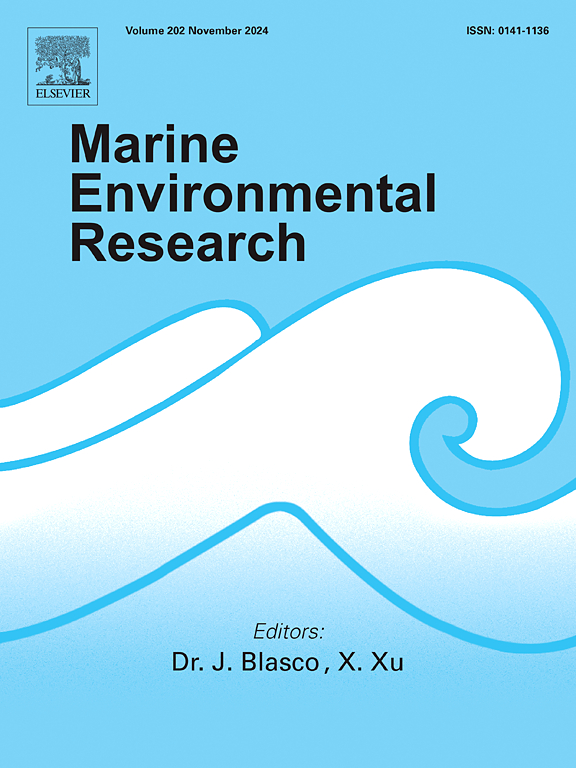Spectral characteristics of organic matter from algae and its complexation with copper: a case study of Ulva prolifera
IF 3.2
3区 环境科学与生态学
Q2 ENVIRONMENTAL SCIENCES
引用次数: 0
Abstract
The changes in dissolved organic matter (DOM) during algal decay play a crucial role in the biochemical processes in nearshore ecosystems. The decay processes of Ulva prolifera under dark and light conditions were simulated in laboratory to investigate the characteristics of the DOM released during its settlement. The spectral characteristics of Ulva prolifera-DOM were analyzed using ultraviolet–visible spectra (UV–Vis) and fluorescence excitation-emission matrix spectroscopy combined with parallel factor analysis (EEMs-PARAFAC), and the copper complexation characteristics were evaluated by anodic stripping voltammetry (ASV). It was found that the DOM derived from Ulva prolifera decay contained labile substances and was sensitive to light, which had significant metal complexation abilities. In dark, relatively high molecular weight DOM was released and then transformed into humic-like substances with a high degree of humification and aromaticity. DOM with stronger copper complexation ability and more copper complexing sites gradually became the dominant. EEMs-PARAFAC showed the DOM was composed of humic-like components C1, C3, tryptophan-like component C2, fulvic acid-like component C4, and tyrosine-like component C6 in the dark degradation, while under light, the DOM was composed of C1, C2, C3, C6 and fulvic acid-like component C5. Lower levels of DOM were released under light. Fulvic acid was the main component with a relatively low degree of humification. The copper complexation capacity (CuCC) and conditional stability constants (log K) increased first and then declined rapidly, with the data significantly lower than those of the degradation in dark at the end of the experiment.

藻类中有机物的光谱特征及其与铜的络合作用:以增生Ulva为例
藻类腐烂过程中溶解有机物(DOM)的变化在近岸生态系统的生化过程中起着至关重要的作用。通过室内模拟黑光条件下增殖榆的衰变过程,研究其沉降过程中释放的DOM的特性。采用紫外可见光谱(UV-Vis)和荧光激发-发射矩阵光谱结合平行因子分析(EEMs-PARAFAC)分析了Ulva prolifera-DOM的光谱特性,并采用阳极溶出伏安法(ASV)评价了铜的络合特性。研究发现,增生Ulva腐烂产物DOM含有易挥发物质,对光敏感,具有明显的金属络合能力。在黑暗中,释放出相对高分子量的DOM,转化为腐殖质样物质,腐殖质化程度高,芳香性强。铜络合能力强、铜络合位点多的DOM逐渐占主导地位。EEMs-PARAFAC显示,在暗降解条件下,DOM主要由腐殖质样成分C1、C3、色氨酸样成分C2、黄腐酸样成分C4和酪氨酸样成分C6组成,而在光降解条件下,DOM主要由C1、C2、C3、C6和黄腐酸样成分C5组成。较低水平的DOM在光照下释放。腐殖化程度较低,黄腐酸为主要成分。铜络合容量(CuCC)和条件稳定常数(log K)先上升后迅速下降,实验结束时的数据明显低于暗降解的数据。
本文章由计算机程序翻译,如有差异,请以英文原文为准。
求助全文
约1分钟内获得全文
求助全文
来源期刊

Marine environmental research
环境科学-毒理学
CiteScore
5.90
自引率
3.00%
发文量
217
审稿时长
46 days
期刊介绍:
Marine Environmental Research publishes original research papers on chemical, physical, and biological interactions in the oceans and coastal waters. The journal serves as a forum for new information on biology, chemistry, and toxicology and syntheses that advance understanding of marine environmental processes.
Submission of multidisciplinary studies is encouraged. Studies that utilize experimental approaches to clarify the roles of anthropogenic and natural causes of changes in marine ecosystems are especially welcome, as are those studies that represent new developments of a theoretical or conceptual aspect of marine science. All papers published in this journal are reviewed by qualified peers prior to acceptance and publication. Examples of topics considered to be appropriate for the journal include, but are not limited to, the following:
– The extent, persistence, and consequences of change and the recovery from such change in natural marine systems
– The biochemical, physiological, and ecological consequences of contaminants to marine organisms and ecosystems
– The biogeochemistry of naturally occurring and anthropogenic substances
– Models that describe and predict the above processes
– Monitoring studies, to the extent that their results provide new information on functional processes
– Methodological papers describing improved quantitative techniques for the marine sciences.
 求助内容:
求助内容: 应助结果提醒方式:
应助结果提醒方式:


